Gear
Over 4th of July weekend I took Eric Pfleger’s Longrifle class. The class was at Thunder Valley Precision in eastern Ohio, the same venue where I took my first class from Eric back in 2011.
I brought two rifles for this class, a bolt gun and a semi-auto. The bolt gun was a Savage Model 110 in .300 Win Mag. It’s topped by a Leupold Mark 4 3.5-10x scope with mil turrets and a TMR reticle. This has a VersaPod bipod on an adapter screwed into the front sling mount. I shot all handloads using moly coated 230 grain Berger Tactical Hybrids. The semi was an AR with a JP Rifles upper on a lower that I put together myself. I ran it with a Mini4 suppressor. The optic on this gun is a Leupold Mark 6 1-6x. It rests on an Atlas bipod attached to a picatinny rail section using a QD adapter. I fed this the Fiocchi loading of the 77 grain Sierra MatchKing. I brought along an iron sighted Glock as my field pistol, in a dropped and offset Safariland ALS holster.
The other students in the class brought a good mix of semi-autos and bolt guns (like me, several students brought multiple rifles). .308 was the most popular caliber by a big margin, but there were some magnums and .223s in evidence as well. The .308 semi-autos were represented by a M1A and a pair of PTRs. The magnums (all bolt guns) included a .338 Lapua and a 7mm mag. There was also one .308 bolt gun (a very nice model in an AICS stock). The only other .223 was a 20″ Bushmaster. Eric brought a small arsenal of his own. His primary gun for the class was his .308 Remington 700 (which doubles as his ‘work gun’ as a SWAT sniper), but he also brought along a .300 Win Mag, a .50 BMG, and several more long guns that never made it out of the back of the truck (as well as a couple of nice looking AR pistols for “social purposes”). Linda brought REPR as well. There were several suppressors in evidence in addition to my Mini4, including a Silencerco Saker and a YHM Phantom.
In addition to the optics on my rifles, I also brought along a couple of support optics. For general use I had a pair of 8x Vortex Viper R/T binoculars. They were particularly nice in that they fit easily in the cargo pocket of a set of BDUs. I also brought along a Vortex 8x monocular. For ranging I had my Leica 1600 laser rangefinder. Finally, on spotting duty was my Leupold Mark 4 12-40x spotting scope with a Horus reticle. I did make one addition to my spotting setup: a small camp stool. The compact tripod I have it on is kind of short for use when standing. Before if I didn’t have a chair handy I either had to lower the tripod all the way down for use in prone or hunch over rather uncomfortably to use it. The stool makes spotting for an extended period much more plesant.
To carry my support gear I brought my usual Eberlestock Halftrack pack. It was filled with a combination of shooting gear (bipods, rear bag, shooting mat, rangefinder) and sustainment gear (water bladders, rain gear, TP, etc.).
I wore multicam for this class, and given the truly hellacious amount of ticks I encountered when I was out here four years ago, I treated it with Permethrin insect repellent before coming. Pretty much everyone else brought some sort of cammo, with multicam being the most common. There was also a fair amount of civilian hunting cammo, along with some old school woodland BDUs. One student took the unique course of bringing a camouflage bug suit and wearing it over his regular clothing.
Thursday
I was able to take advantage of a conference in Branson, Missouri earlier in the week to get a little bit of a headstart on my trip to eastern Ohio. Even so, it was a day and a half drive to get to New Philadelphia, Ohio where we’d be staying. I pulled in to the hotel parking lot at around 7:30 and who do I find in the parking lot pulling gear out of the back of a big pickup truck but Eric. We shot the breeze a bit. Once we realized that neither of us had eaten we headed over to a nearby barbecue place along with Eric’s family. After a nice meal and some good conversation we agreed to meet early tomorrow to convoy out to the range.
Friday
I rolled out of bed early on Friday and met up with Eric and a few other students at the hotel breakfast room (where the choices were rather meager). We left before 0700 and convoyed out to Thunder Valley Precision.
One of the students brought a four wheeler and he and Eric headed out onto the range to set up some street signs for ranging exercises and some additional steel (there was already a bunch of fixed steel out there, but Eric wanted one plate per team available at each distance from 200-600 yards). The rest of us prepped our gear back at the firing line.
When 9 o’clock rolled around we got started. After the usual administrative business (waivers, etc.) Eric delivered a detailed medical briefing, assigning people to different roles. He followed this with a safety briefing that emphasized both the traditional four rules of gun safety and some rules specific to the range and class (mostly involving having rifles loaded only when in firing positions, not behind the line or when on a stalk).
Eric paired us up into 2-man shooter/spotter teams. I teamed up with Georro, who I knew from several of Roger Phillips’ classes, but hadn’t had a chance to see in over a year.
First up was a gear lecture. Unlike a lot of “sniper” classes we didn’t spend much time talking about rifles or optics (given the kit that people brought I think Eric felt everyone was pretty squared away on that front). Instead it focused on all of the ancillary gear required to carry out the sniper mission. The mechanism Eric used for this was his “grab and go” ruck that he uses in his role as a SWAT sniper in Montana (given the rural nature of his area, Eric’s job is much closer to a military sniper than the typical SWAT sniper’s).
First off, though, he went through the gear he wanted us to have on us at absolutely all times during the class: a notepad and pen (not much trouble for me), binoculars, and a loaded pistol. These represent the absolute minimum you need to be an effective spotter or observer. Binoculars to see with, a notepad and pen to write down what you see, and a pistol for self defense and to cover the sniper’s back.
Eric went through his gear, starting with stuff he carries on his person and moving on to gear in his pack. It was pretty much the same setup he described last year in the Pathfinder, Recce, and Man Tracking class up in Montana. I’m not going to go through it in detail, but it filled about 8 pages of my little notebook (Eric really needs to write this up in an article).
After he finished up the gear lecture, we did a quick Kim’s game. Eric had about 15 items sitting out underneath a piece of cloth. He pulled the cloth off and gave us two minutes to memorize all the items in as much detail as we could manage.
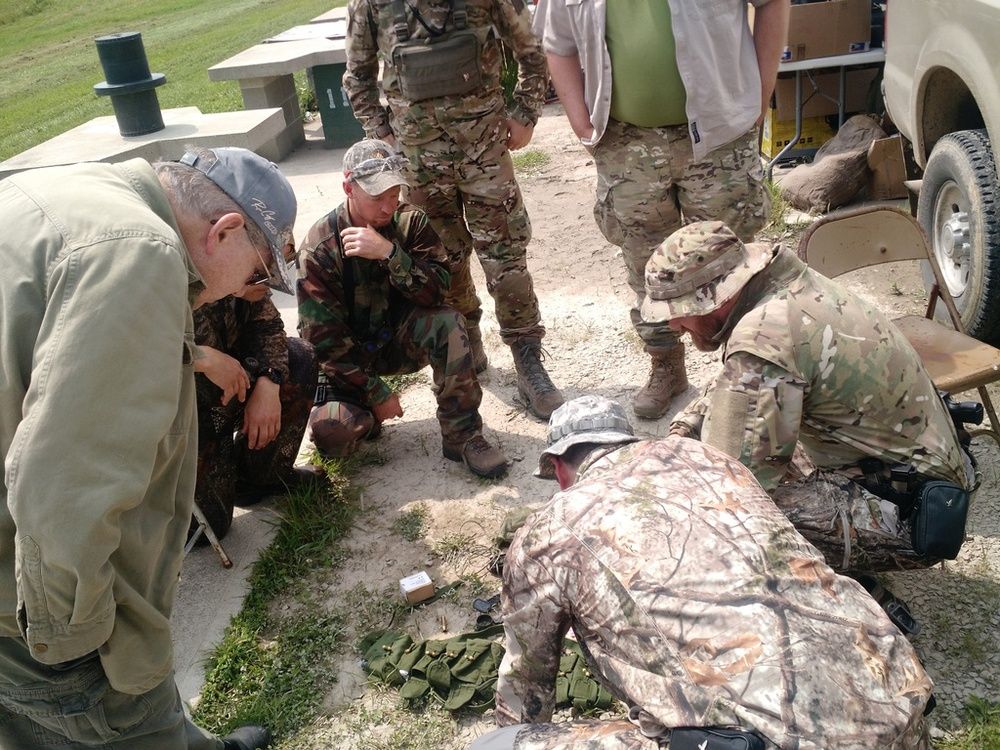
One of the things that Eric really emphasized was effective communication between the shooter and spotter. Unless called for by a specific exercise, he did not want a single round to go downrange in this class without a spotter observing it.
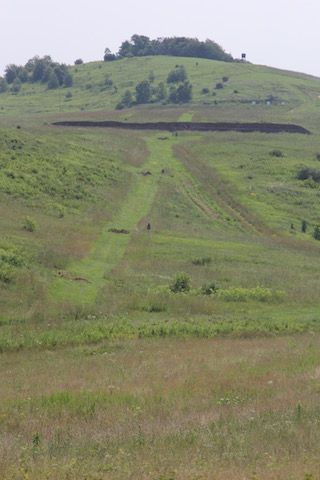

With that, it was time to get shooting. Thunder Valley Precision is a big facility, with lots of targets and shooting positions spread out over a wide area. For most of the class we’d be shooting from the main firing line. This looks out over a valley about 500 yards long, onto a hill stretching another 500 yards. There are steel targets at 200, 300, 400, 500, and 600 yards, with enough targets at each distance to assign one to each team. There were also a couple of targets at 1000 and a pair on a more distant hillside at a full mile. Eric took advantage of the facility by dedicating a lot of the class time to self-paced shooting. Teams were free to engage any of the available steel targets, allowing us to practice where we needed to and to work up dope for our rifles.
First though, Georro needed to get the optic on his rifle zeroed. The range is actually really well set up for this sort of thing, with a single target at 100 yards set at 90 degrees from the main range, allowing for individuals to zero rifles or engage in other exercises while longer distance shooting continues on the main range. Georro got his rifle (a suppressed Remington 700 in an AICS stock) zeroed in pretty short order and turned the side range over to another team who had several rifles to zero.
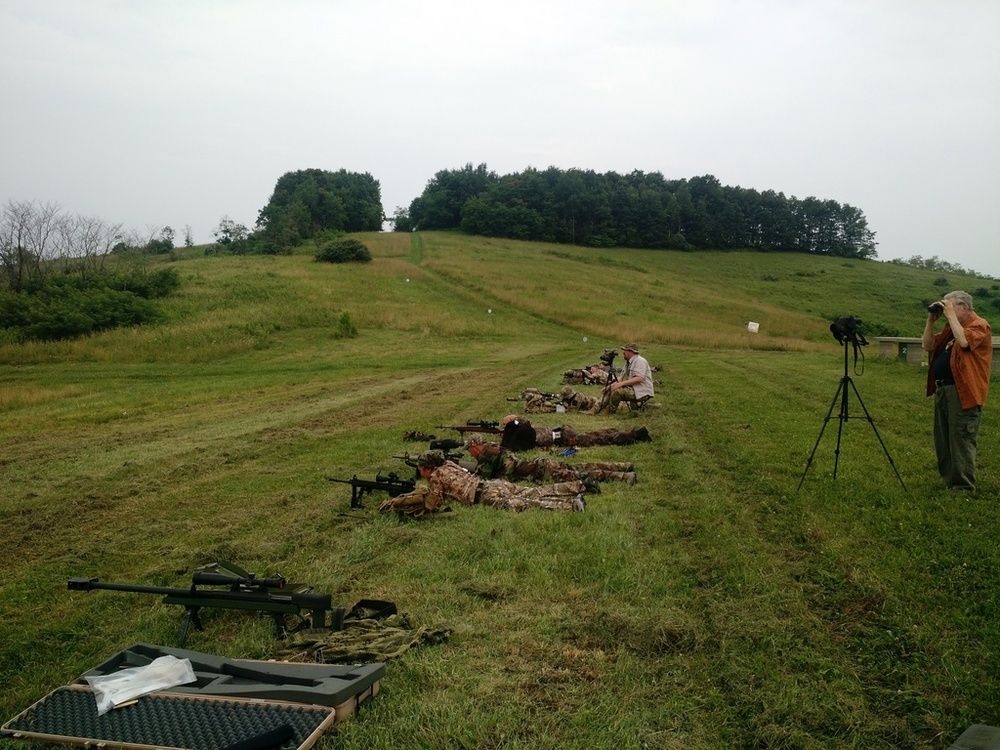
We got set up on the firing line and got to work. We decided that the logical thing to do was to start at 200 and work our way out. I brought out both my Win Mag and my DMR and shot both of them at each distance. We switched off between shooting and spotting using my spotting scope.
In theory, the AR was zeroed at 200 yards and the Win Mag at 300 yards. However, I hadn’t actually been able to zero either of these at those ranges. I’d measured their velocity on a chronograph, did some ballistic tables in a computer program, and then zeroed them a specified number of inches high at 100 yards. This is not the optimal way to do this. First off, my chronographed velocity may be off. Second, relatively small zeroing errors at 100 yards can result in much bigger errors downrange at the second intersection. So my first priority was to verify where these rifles were actually shooting at their nominal zero distances and make adjustments if necessary.
Two of the 200 yard targets were homemade steel swingers with about 6″ disks. These were a bit smaller than the 10“x10” plate that was our assigned target at this distance, and since the team assigned to one of them was still zeroing their rifles, we decided to use one of them to help get a better idea where our rifles were shooting. This worked fine for Georro’s .308 and my AR, but when I hit it with my Win Mag it bent the plate back about 30 degrees on the shaft and knocked it for a full 360 degree swing. Eric later hit that same plate with a student’s PTR and knocked it clean off the swing arm. I don’t think it was really made for close range hits from a .300 Win Mag (Eric was a good sport about it though).
At 200 yards both rifles where shooting a tad low. I made a small adjustment to the AR’s zero to bring it into line with where it was supposed to be shooting. Since I wanted a 300 yard zero on the Win Mag I just noted that it was about 0.2 mils low, but held off on making any correction until I shot it at 300.
Moving on to 300, I found the Savage was shooting about 0.3 mils low. Since it was supposed to be dead on at this distance I went ahead and made a correction and set the turret back to zero. The change I had made to the AR back at 200 seemed to have done the trick and I was dead on for elevation.
The drop on both rifles was right in line with my dope from the ballistics program at 400 yards. The AR had been shooting a shade to the right at 200 and 300, and at 400 this was even more pronnounced, despite the lack of any appreciable wind. I went ahead and adjusted my zero 0.2 mils to the right, which brought it right back into line windage wise. At this point I was pretty confident in my dope for both rifles.

At 500, the Savage was dead on, with no issues. I did start to run into some difficulty with the AR, specifically with the optic. At 6 power the reticle on the Mark 6 is a bit coarse (it has to be if you want to be able to see it at the lower powers). I’d been able to use this same optic on a Knights upper to good effect out to 700 yards in John Chambers’ DMR class last year, but there we were shooting steel IPSC torsos. Most of the targets here were 10“x10” plates, with one larger (but not IPSC sized) silhouette target at each range. Out at 500 yards the reticle was covering most of those 10x10 plates, making it hard to keep the crosshairs centered. The silhouettes were a bit bigger, but even they were only about a foot wide (and unpainted steel, which was harder to see than the painted squares). The rifle was still able to get absolutely consistent hits with the right hold, even consistently hitting the same part of the target. The rifle clearly has more accuracy than the optic can really take advantage of. I’d figured that a 6 power optic was good enough to take full advantage of the useful range of the 5.56mm round, and that’s true on torso targets. However, this rifle clearly has enough accuracy to do considerably better than torso targets, if it were paired with some more magnification and a finer reticle.
Before we moved out to 600, Eric called everyone over and went through the sitting and kneeling positions, as well as showing how to use your spotter, or an object like a rifle for additional support.
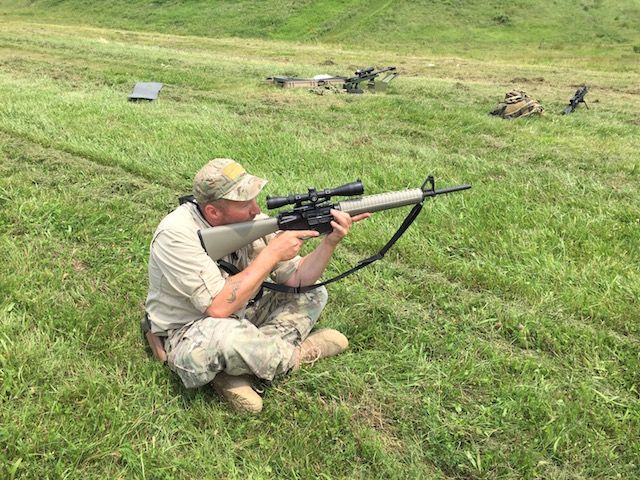

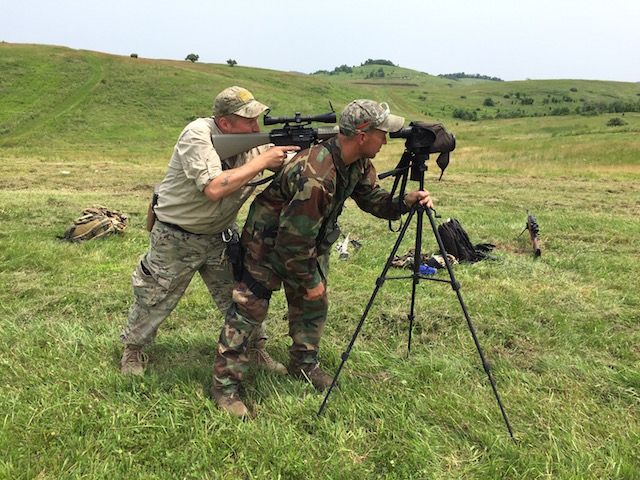


Heading back out to 600 yards, I got good hits with the Savage and managed a few with the AR, despite the reticle issues.
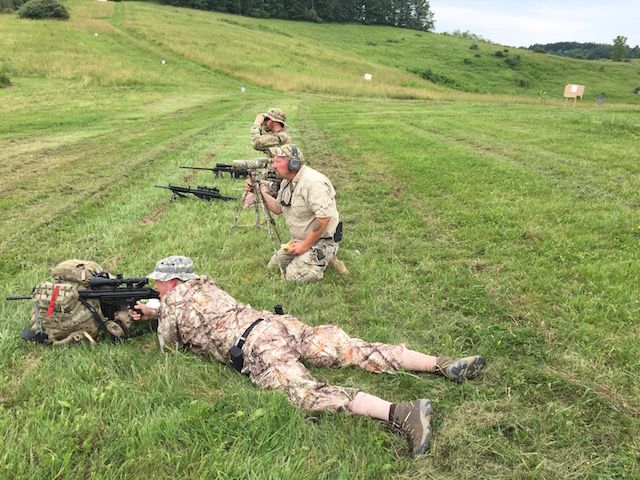
Eric did some lecture on ranging with mil reticles. He handed out some “cheat sheets” with the various formulas and the sizes of some example objects like street signs and license plates. He worked through a couple of ranging examples on the whiteboard.
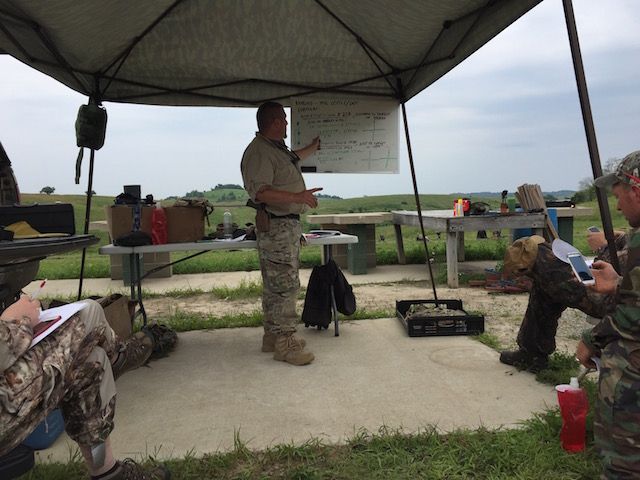
To apply what we’d learned, Eric had placed some street signs and a couple of license plates out at various distances on the range. He asked us to first make a guess about how far each object was, then mil them and run the math to figure out how far they were. Eric loaned a spotting scope with a mil reticle to one team so everyone had a good mil reticle optic available. I used my Leupold Mark 4 spotter with the Horus reticle and Georro ran his 4-16 Nightforce with a mil reticle in it.
Once everyone had ranged with mils, we broke out the laser rangefinders and measured the distance. We generally did pretty well. For 4 out of the 7 we were within 5 yards of the correct value. On two more we were within 10% of the true distance. The only one where we were off a substantial amount was a street sign where the only dimension we knew and could range off of was its 6″ height.
Finishing up the mil ranging exercise, Eric did a quick lecture on reading the wind. We debreifed the Kim’s game from the morning. Eric had us list out what we’d seen, then he pulled back the cloth and showed us what was actually there.
We headed over to a nearby area for a different sort of observation exercise. Rather than focusing on memorization, this one was oriented towards actually seeing hidden objects. Eric had placed a set of manmade objects in a nearby copse of trees and we had to try and find them from about 50 meters away. Georro and I did pretty well, but some of the objects were really hard to find (like a .308 case on the end of a branch).
We got a bit of rain, but it was fairly brief and not very hard.
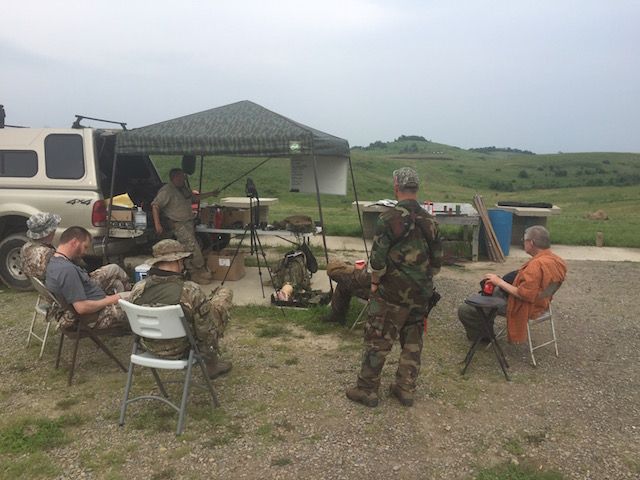
Eric went ahead and did his camouflage lecture, oriented around his usual structure of the 10 deadly “S”es: Shape, Shadow, Shine, Silhouette, Spacing, Scent, Speed, Spoor, Sound, and Signal. He went through each one and talked about how you could use it to detect others and how to keep them from detecting you. Along the way he talked about some tools for camouflaging yourself or your position. One of the more unusual ones was a “tactical umbrella”. It started out life as an ordinary umbrella made with woodland camouflage pattern cloth. Eric had attached some cammo netting and strips of burlap, and included some loops on several of the spokes to stake or tie it down. The idea is it can provide a camouflaged visual barrier that’s very quick to set up. Much faster than, say, camouflage netting.
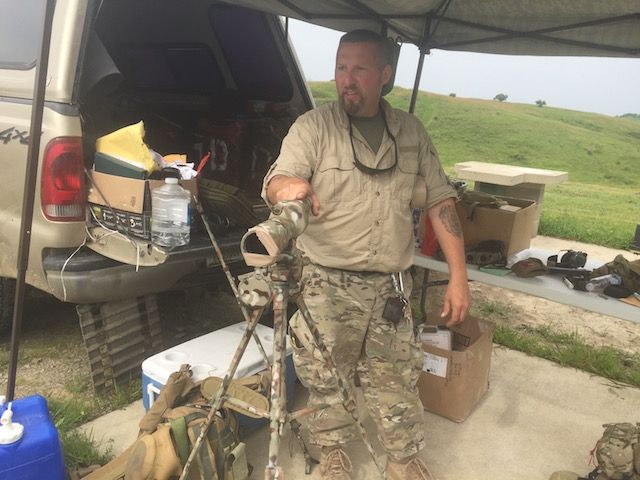
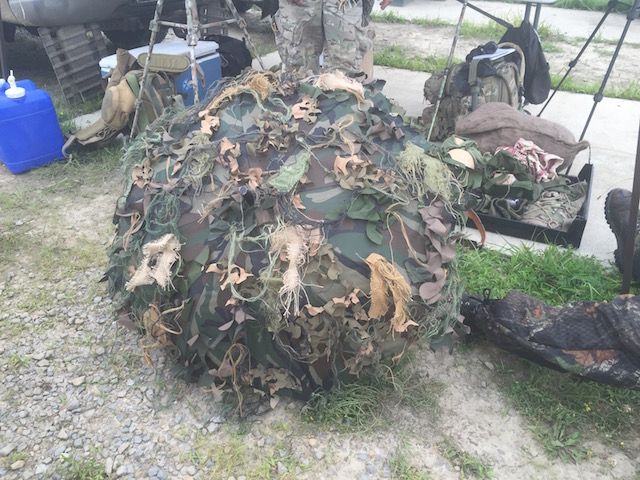
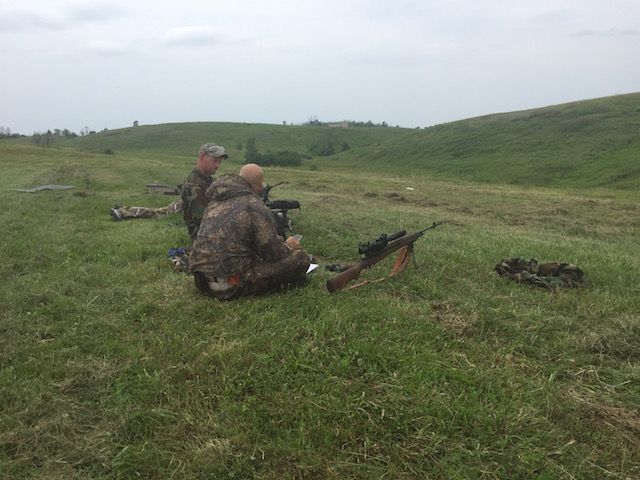
With that we got back to shooting. Having rung the steel at all the distances out to 600, Georro and I moved out beyond it. There was supposed to be a target at 700 yards, but it was missing (there was even a little berm for it and everything, but no steel). Beyond that the terrain dropped off, before rising again at about 1000 yards, which prevented any targets at 800 or 900. So the next target available to us was at 1000.

The plate that we were shooting at was just 10″ by 10″. 1 MOA at 1000 yards, in other words, which is a very challenging target. Given the distance I eschewed the AR and just shot my Savage. In contrast to my experiences out to 600 yards, where my computer generated ballistics chart was at least close, here I started out very high. I had to crank it down almost a full mil.
Even once I had the correction dialed in, I was missing more often than I was hitting. All my misses were within a few inches of the edge of the plate, so I probably would have been consistently hitting a torso-sized target, but on the smaller plate my I was firing several rounds for each hit. To be honest, this 1 MOA plate was probably a little bit beyond the shooter-rifle combination in my case.
One cool thing about this was that atmospheric conditions were very good for bullet trace, so we could watch the shots dropping in at 1000 yards. And of course, when you get a hit at 1000, it’s a mighty long wait for that “ding”. Very cool.
The hour was growing late, so we wrapped things up for the day. Back in New Philadelphia we hit the same barbecue place. During dinner Georro’s wife, Glockgal, made her appearance. It had been quite a while since I’d seen here, so it was nice to get a chance to catch up. As usual, the fellowship and camaraderie after the end of the class day was a real highlight.
Sunday
We headed out early again on Sunday morning. Given the rather meager pickings at the hotel breakfast the day before Eric took us to the range by way of the McDonalds drive through, which was welcome.
Once we got out there, Eric sent the student who brought the four wheeler out to relocate some of the steel and move some of the street signs around. The rest of us prepped our gear and got ready for another day.
We started out day 2 of the class with another Kim’s game, then got to shooting.
Georro and I took advantage of fact that we now had some steel at 700 yards to do some shooting at that distance. I was able to hit quite reliably with the Win Mag, but as with the 1000 yard steel, by computer generated dope was quite a bit high (0.7 mils). I talked a bit about this with Eric later, and he reinforced my conclusion that I probably needed to true my velocity. These loads seemed to be shooting quite a bit faster than the numbers I had gotten off the chronograph.
Glockgal came out to the range this morning and she shot Georro’s rifle for a bit.
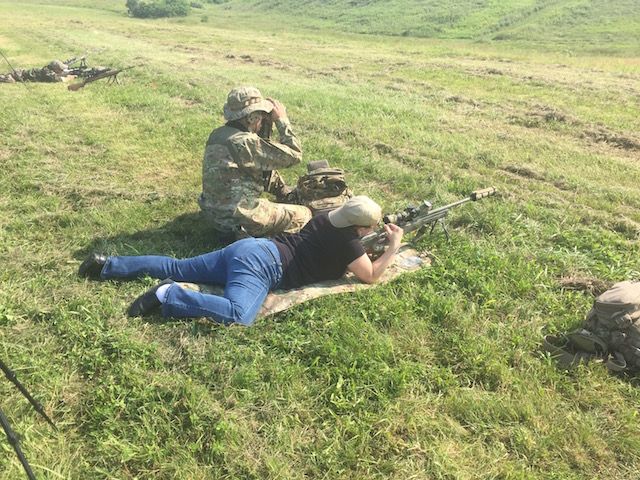
After a bit of free shooting, Eric talked a bit about coordinated fire. When having multiple snipers fire at a single target, it’s useful for all the bullets to arrive at the same moment, so the target doesn’t have a chance to react. One of the shooters (or better yet a third party who’s not shooting) verbally coordinates the fire. The verbiage Eric likes for this sort of thing is, “Sending on three. Sending on one, on two, on BANG”. This sets up a rhythm for all the shooters and obviates the need for a shooter to talk and shoot at the same moment. We practiced this as teams, then did some en-masse coordinated fire with each team simultaneously engaging separate targets.
We went back to more self-paced shooting while Eric pulled teams off the line to run a facial identification and shooting drill. He set up a grid of eight face targets down on the 100 yard side range (where we had zeroed yesterday). He texted each team a picture of one of the faces and they had two minutes to run over, set up in firing position, ID the correct target, and engage using coordinated fire (if you had time left you could launch a second volley).
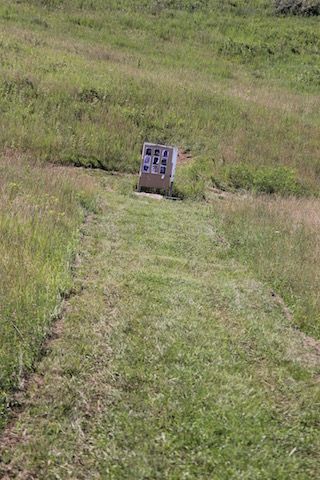
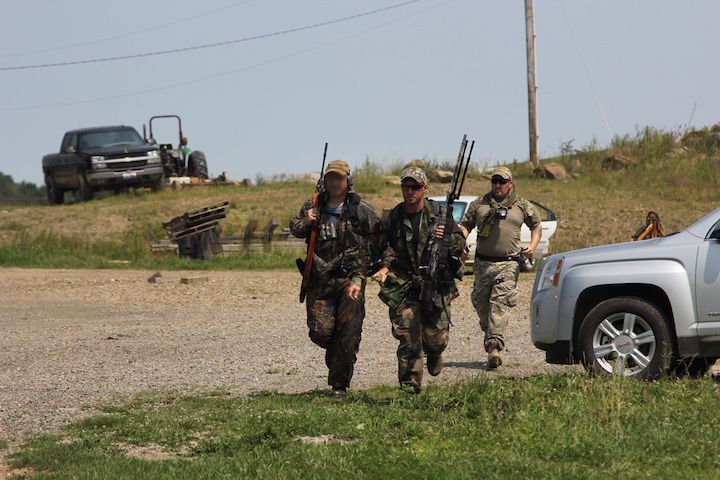
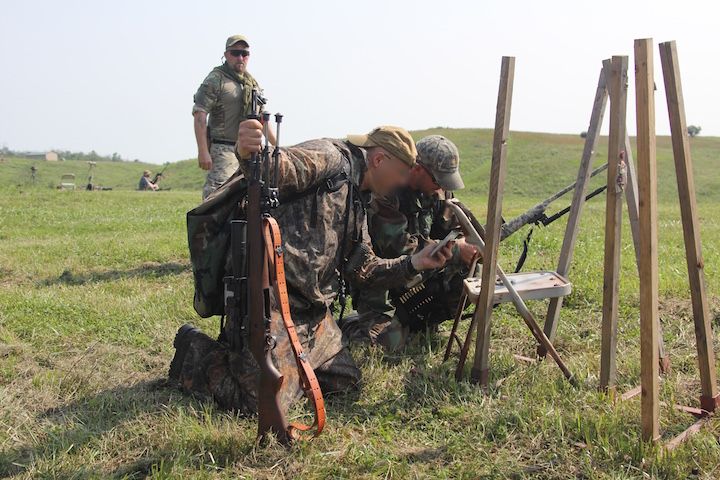
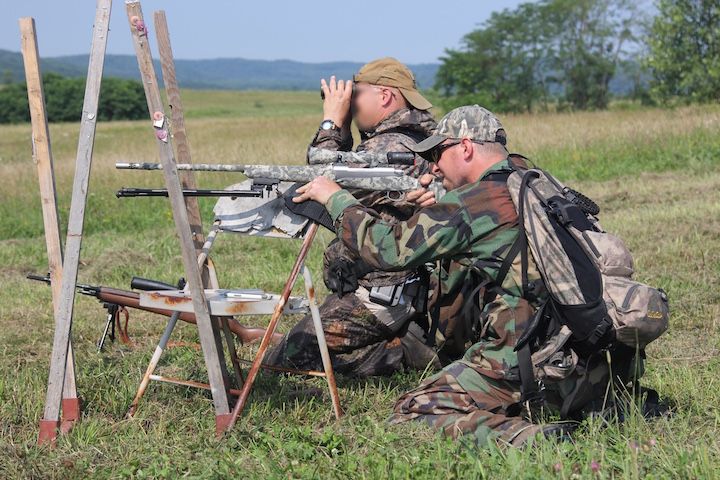

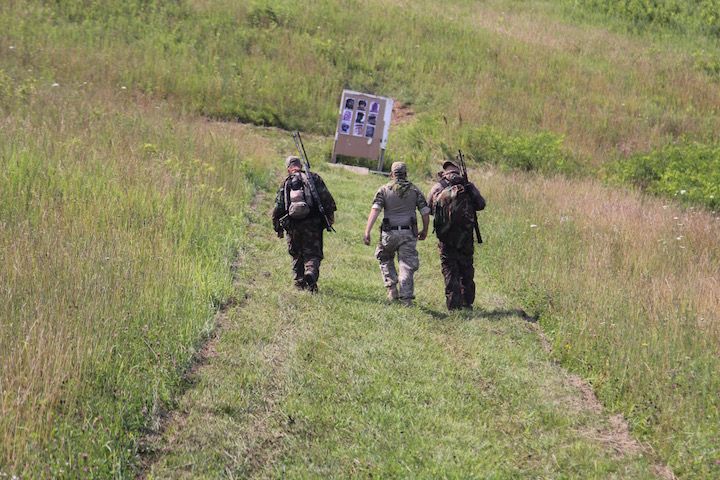
Some of the teams were a bit pressed for time, but when Georro and I ran it we launched our first rounds right at the one minute mark. We got some really nice hits. Since we had time Eric let all the teams run it again. Since they had some experience with the drill he cut the time limit to 90 seconds. Again Georro and I had plenty of time, though this time I overdid my holdunder and dropped a shot a bit low.
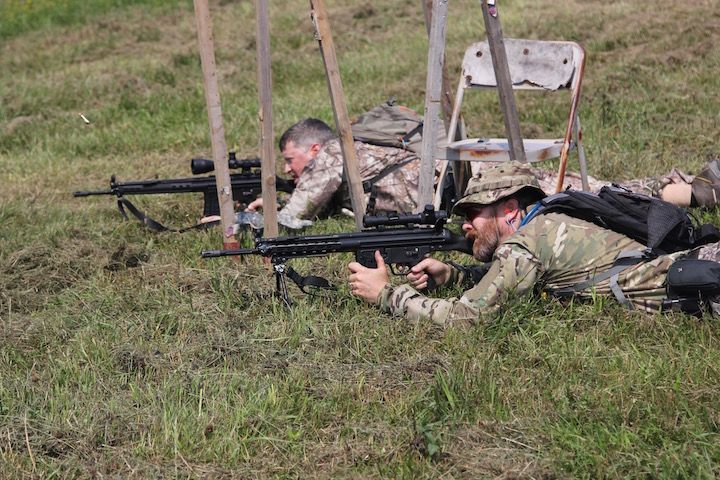
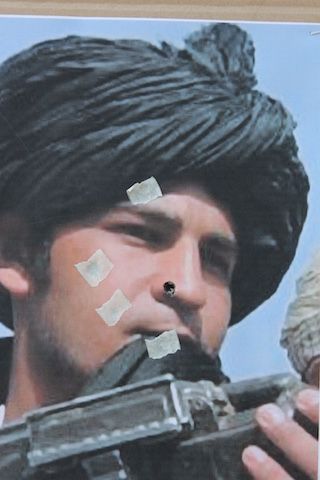
After everyone had a chance to run the target ID exercise a second time, we debriefed the Kim’s game from earlier in the morning.

Next Eric did a lecture on stalking. He showed off some of the different movement techniques, depending on how low you need to get while moving. He also talked about some of the equipment issues that come up when moving on the stalk and showed off a couple of drag bags.
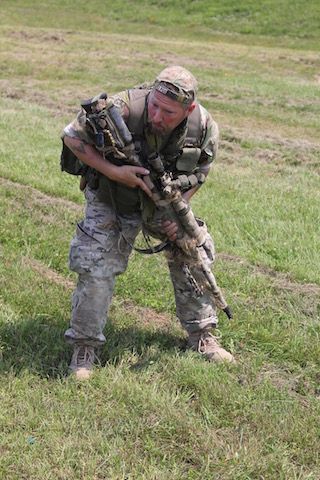
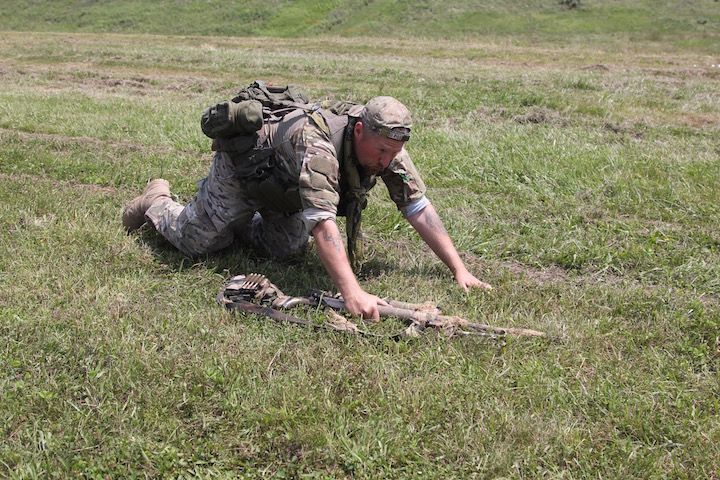
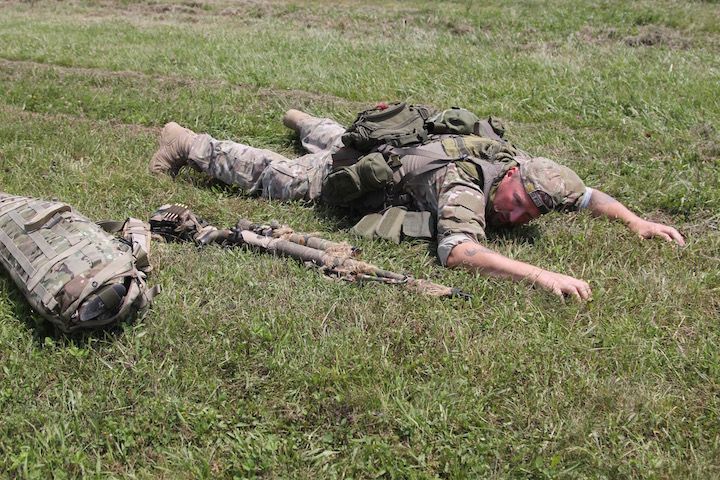
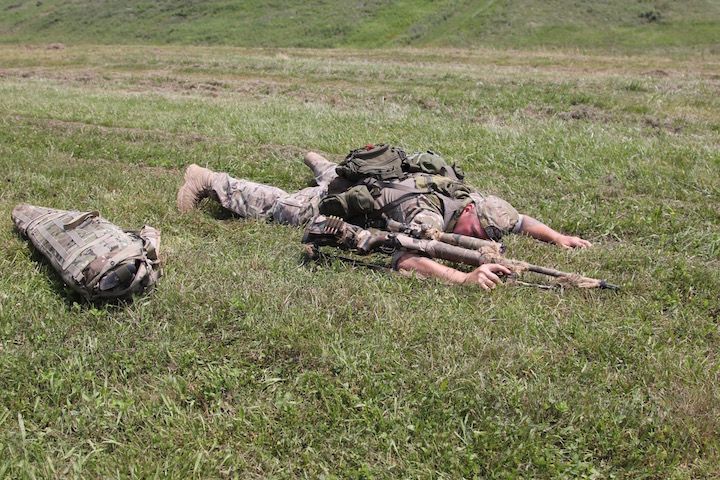
He gave us some time to get our gear squared away, then we headed out. We move up the hill to the right of the firing line, doing some low crawling along the way. While crawling I managed to loose the lens cap off my optic and had to go back and get it (I’d had it come off during recoil a couple of times during the class as well). Once we got up on top of the ridge we moved along the treeline until we got to an open knob on the far end.
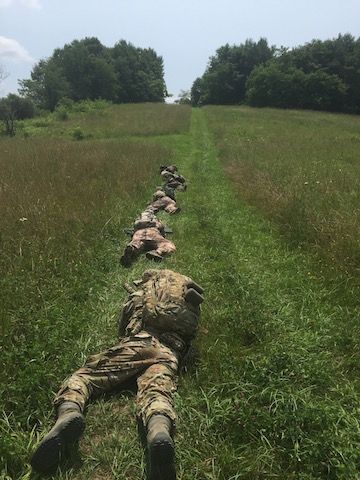

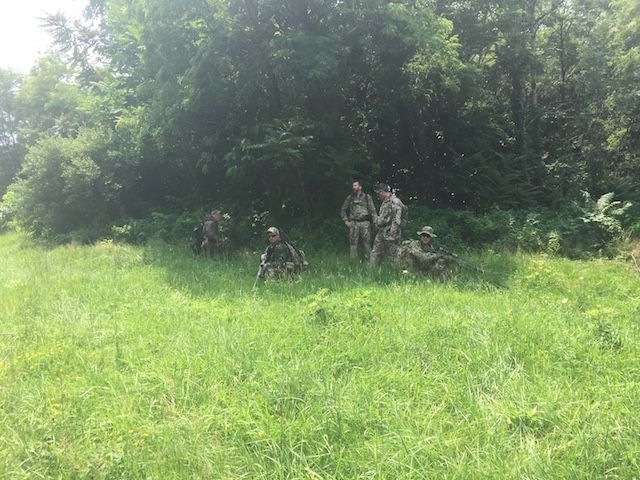
From there we had a nice view that showed some targets we hadn’t seen before and provided a new view of some that we’d already seen. Eric had placed some street signs near three of the targets, so it was time for another miling exercise. This was a bit more challenging for me since I only had my rifle scope rather than the spotting scope I’d used earlier.
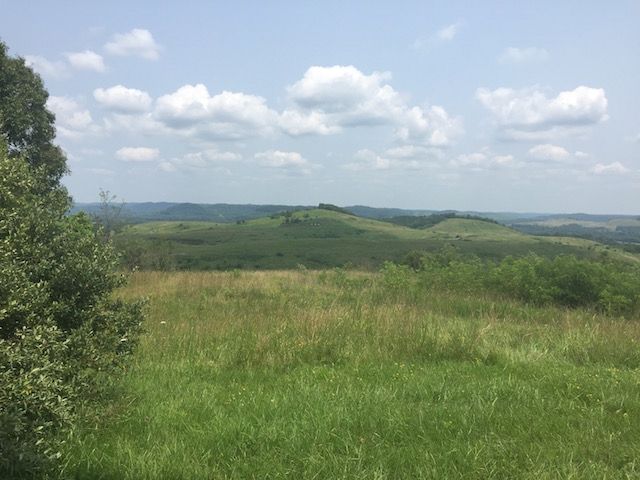

After everyone had miled the targets, we shot them (the steel, not the street signs) based on the ranges we’d calculated. I managed to go three for three on these, which I thought was pretty impressive (Georro was 2 for 3, making us the most accurate of the teams on this exercise). Afterwards we lased the targets to see how close we’d gotten miling them. We were basically right on for all three of them (which probably contributed to our good shooting). This really gave me a lot of confidence in my ability to do mil ranging on targets.
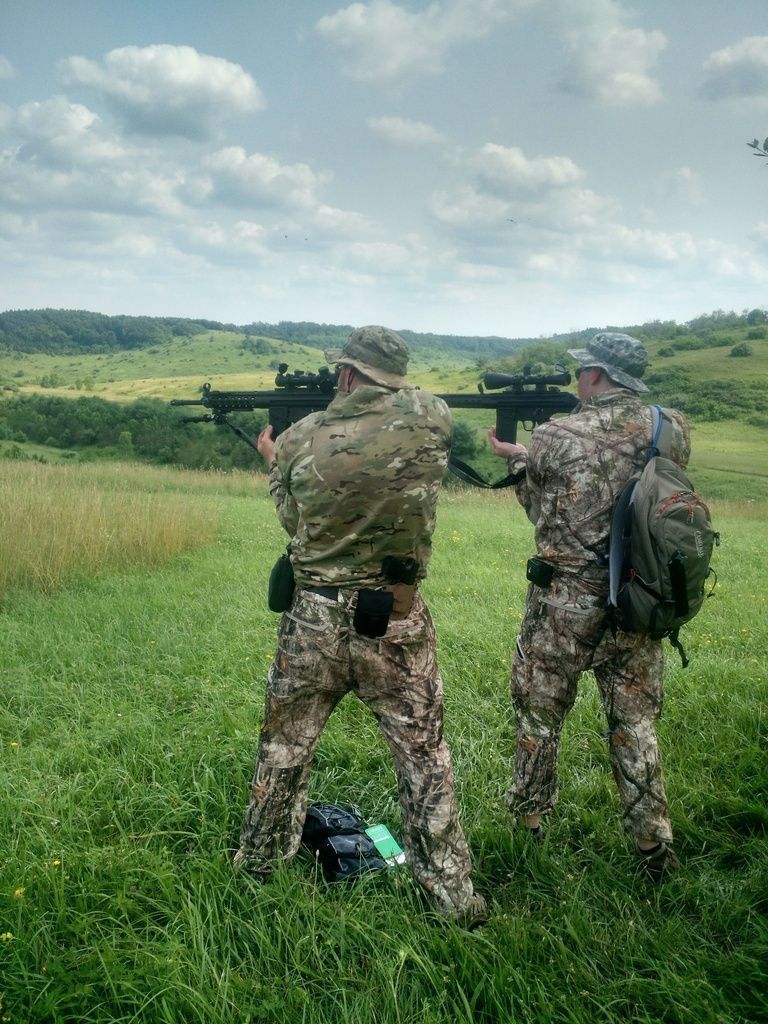
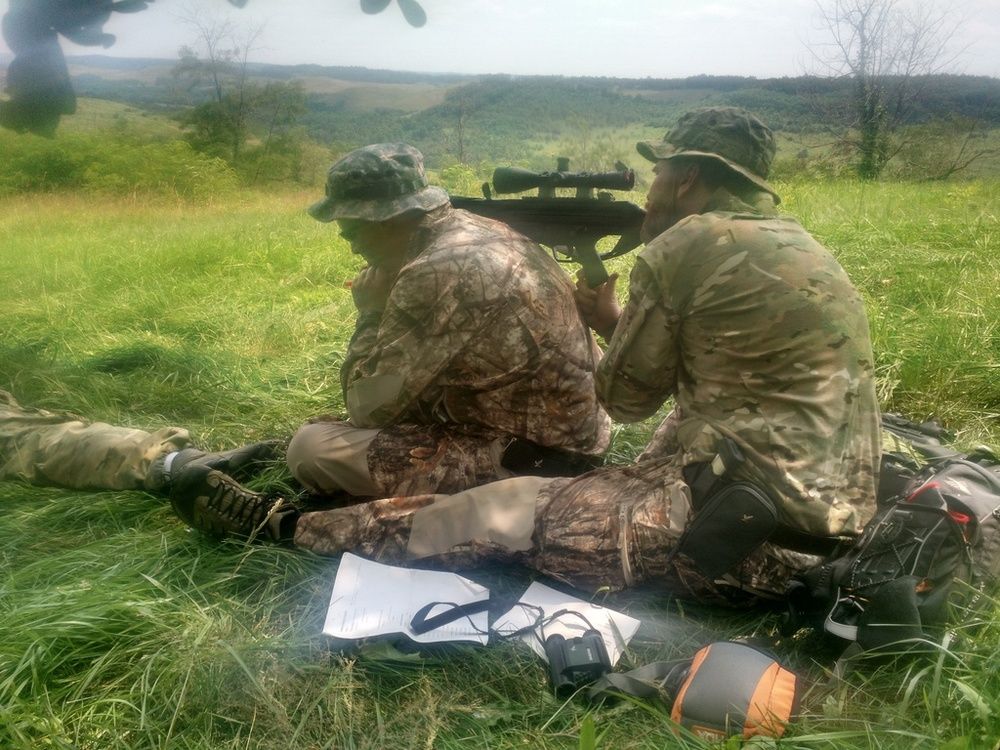
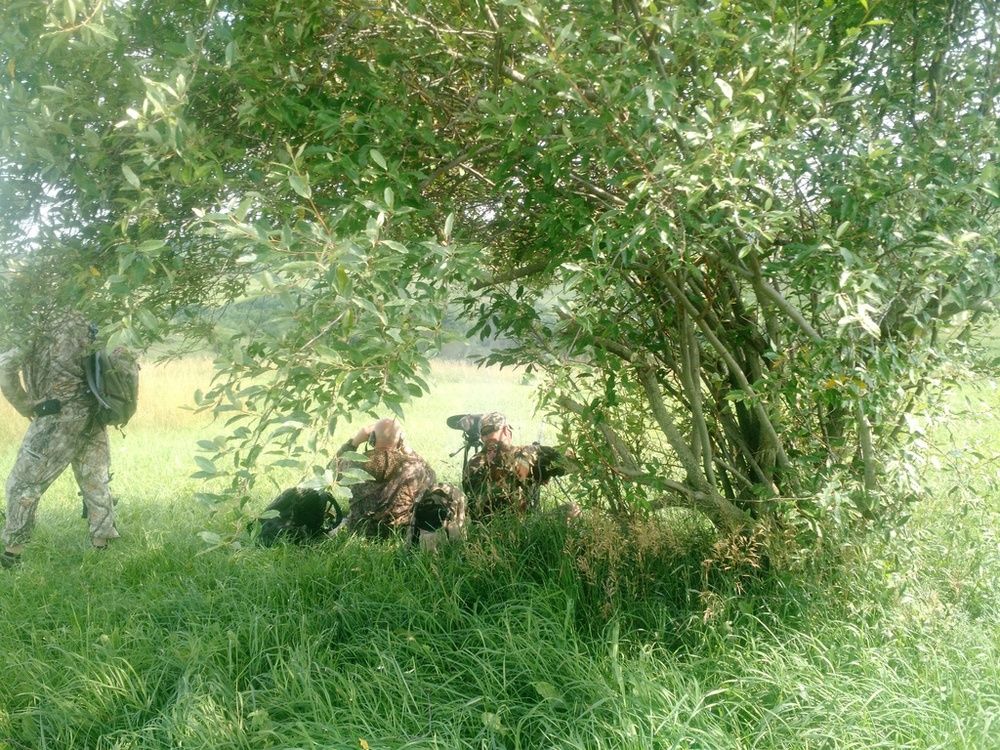
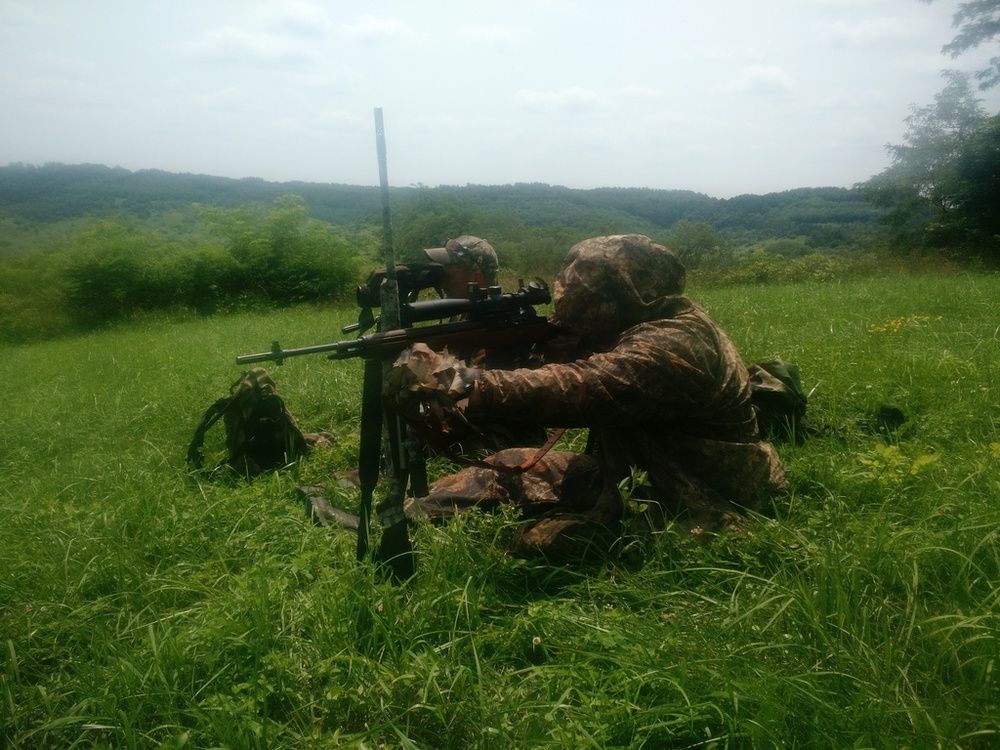
Eric opened it up for some free shooting from this position. Georro and I engaged the 700 yard plate, which was more like 640 from this position and got good hits. We also took on the 1000 yard plate (about 950 from here). I got some good hits, and was actually hitting a bit better than I had been the other day. Again it required quite a bit less elevation than my computer generated ballistics table predicted.
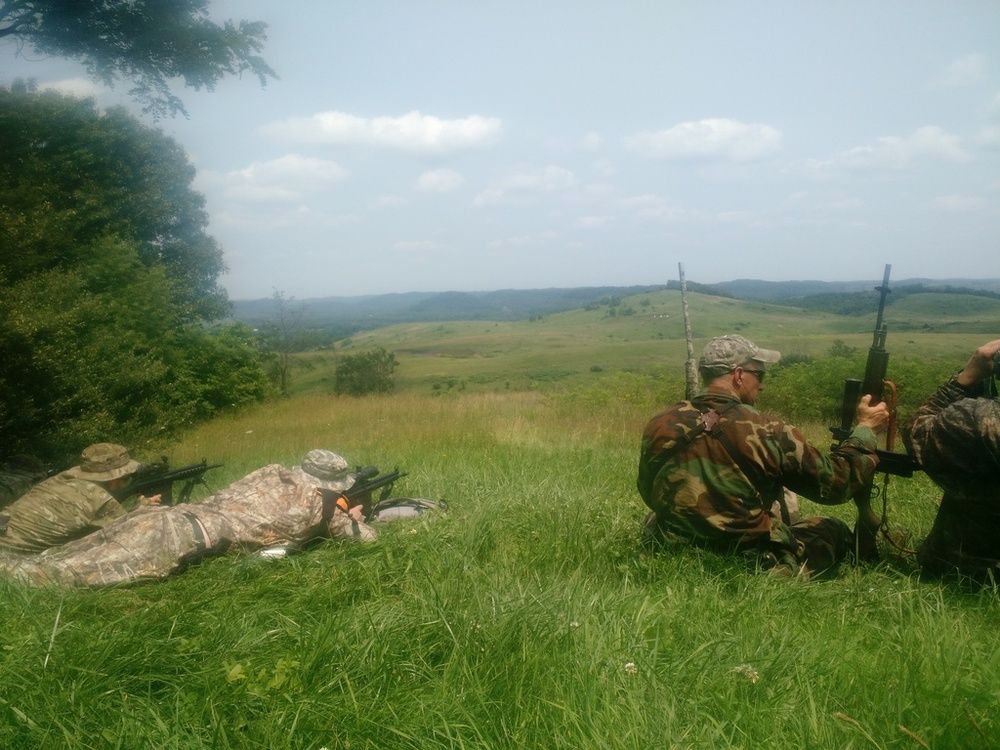
Georro also took some shots at 1000 yards but he had some real trouble. Up until this point wind hadn’t been a real big factor in any of our shooting, but it had picked up a bit. It wasn’t real strong (though even modest wind is a factor at this distance) but it was rather inconsistent. He’d fire a shot and miss right, then make a correction and fire again and miss left because the wind had changed. This is one time when the greater wind-bucking ability of the 230 grain bullets I was shooting was a real advantage.
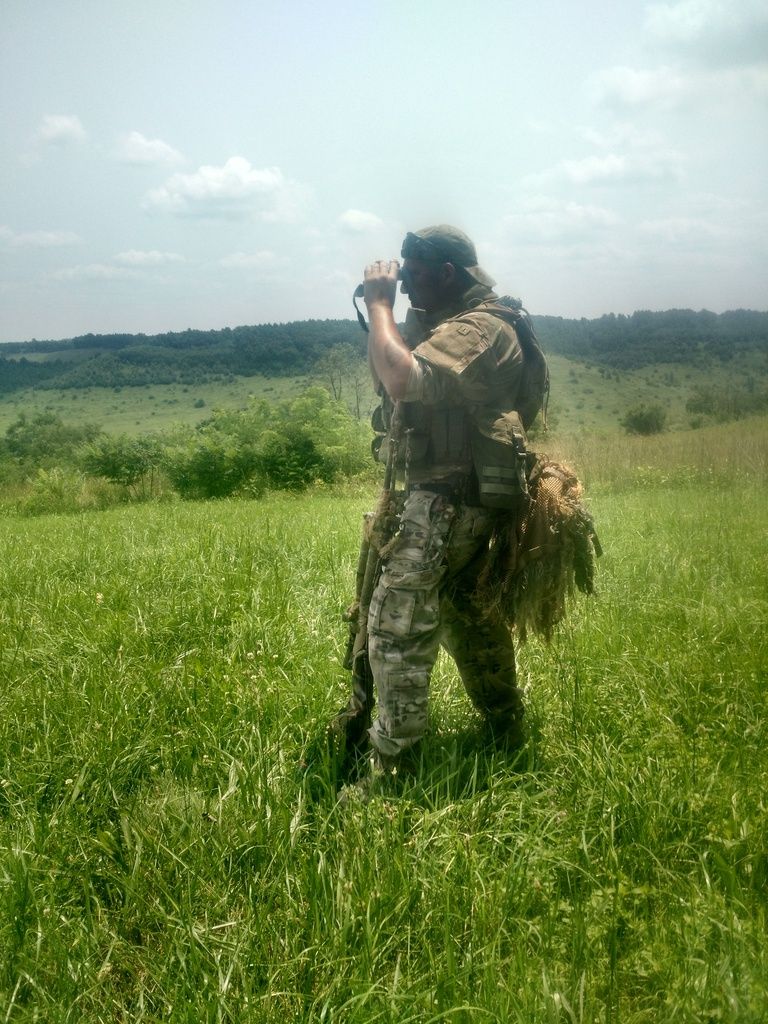
While we were out here I also pointed out that we were getting a bit of mirage, something that Eric had talked about in his wind lecture but hadn’t really been visible until now.
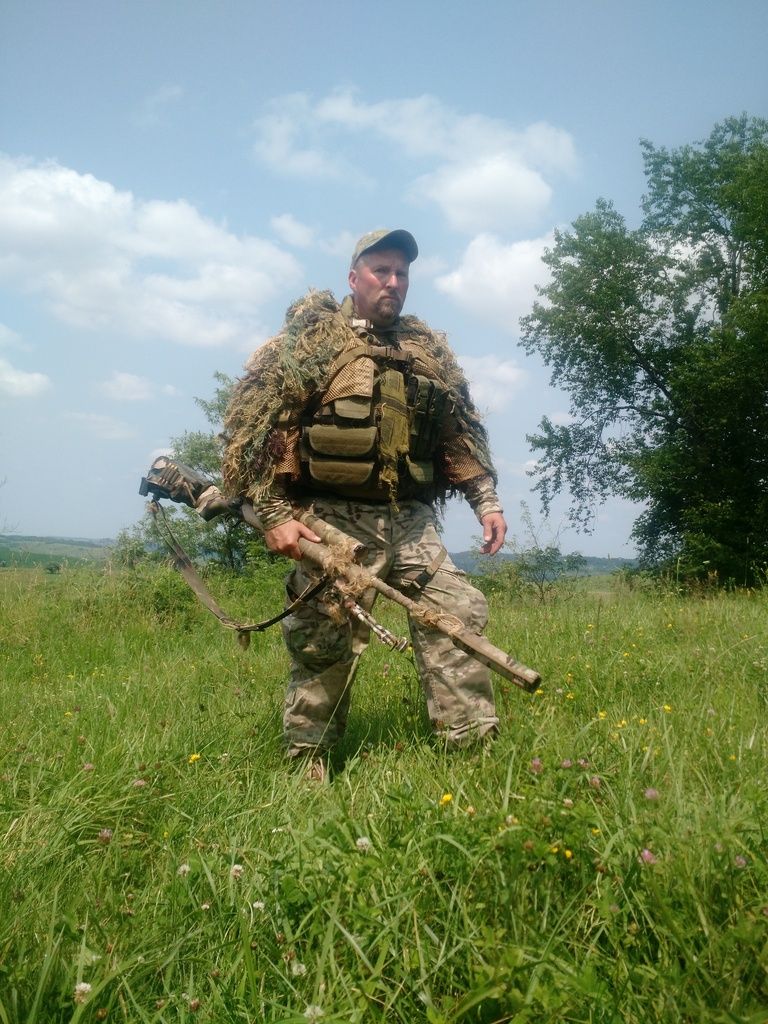
After everyone had a chance to do some shooting, Eric had us move by teams down to the other end of the ridge and set up concealed positions in the brush there (as opposed to the nicely mowed grass where we’d been shooting). Georro and I moved through the woods and took a position between some bushes in some high grass. From here it wasn’t possible to get down prone, so we did our shooting from sitting. Rather than a traditional sitting position, I set my ruck upright in front of me and used it for support.


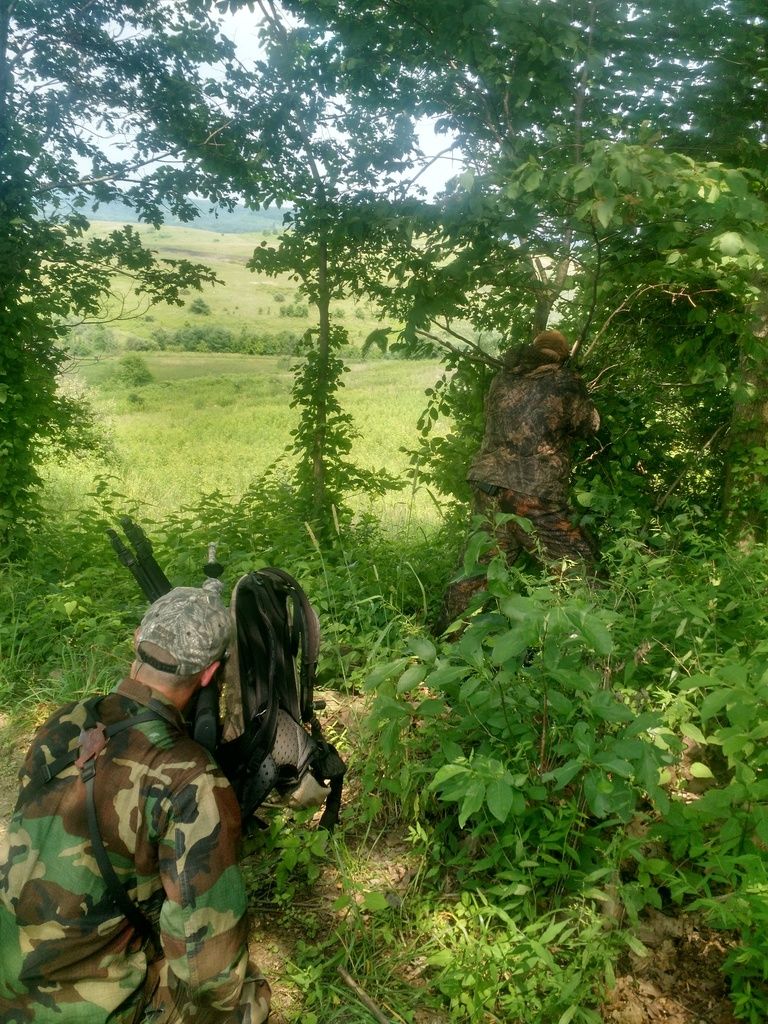
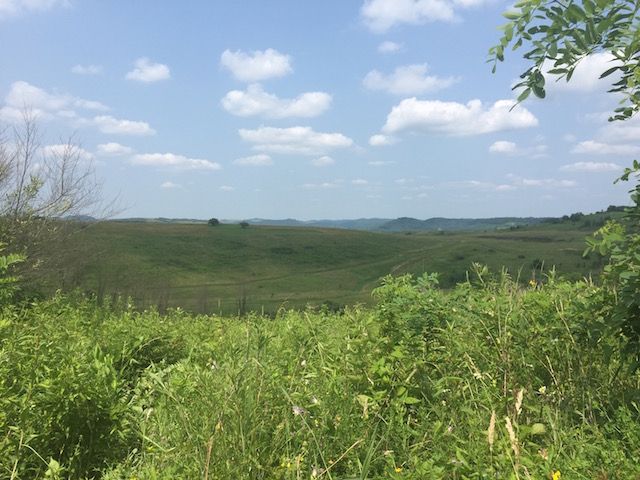
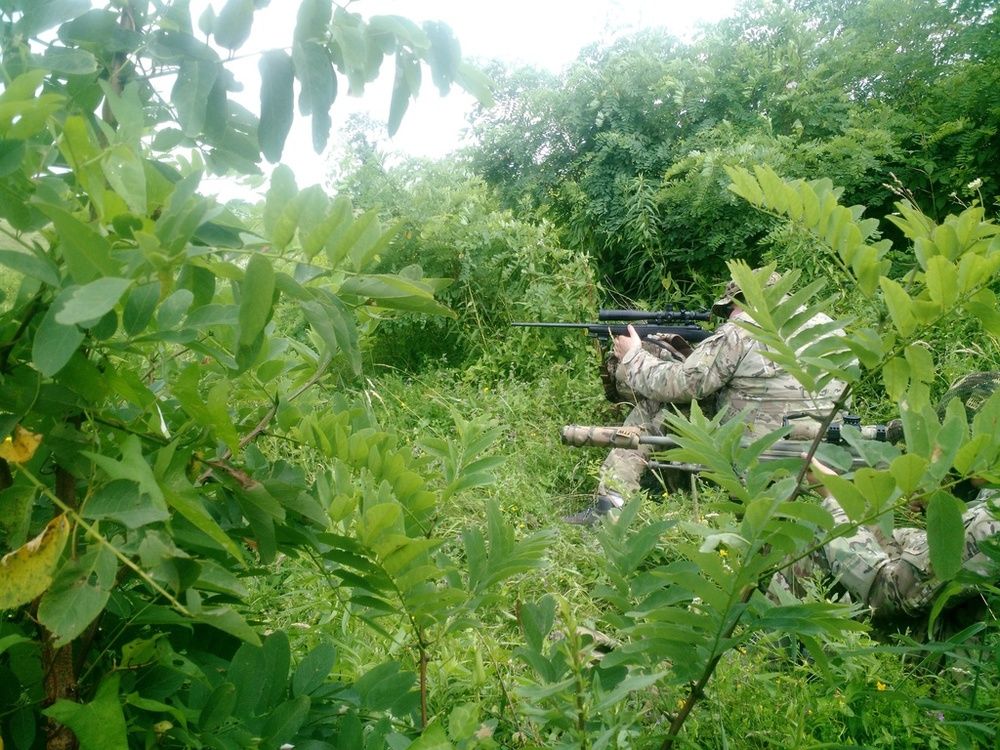

Once all the teams were in place and we had the green light to shoot, we shot the 300 and 400 yard targets (Georro also shot the 500, but I couldn’t find a position that was stable enough for my sights to stay on target). We also engaged a couple of plates on the other side of the valley that weren’t visible from the firing line. One of them was one of the “headhunter” targets: a small circular plate atop a larger square one. It took a couple of shots but I managed to drill the circular head dead center.
After everyone had shot some steel from these positions we headed back to the firing line. It was only a brief stop, however. Having shot from the hill on the right, we moved out to the left side of the valley to another firing position. From here we were shooting back towards our previous positions (indeed, one of the teams had used a plate we were about to shoot at as a supported shooting position). Georro and I got good hits on a couple more targets from this position.
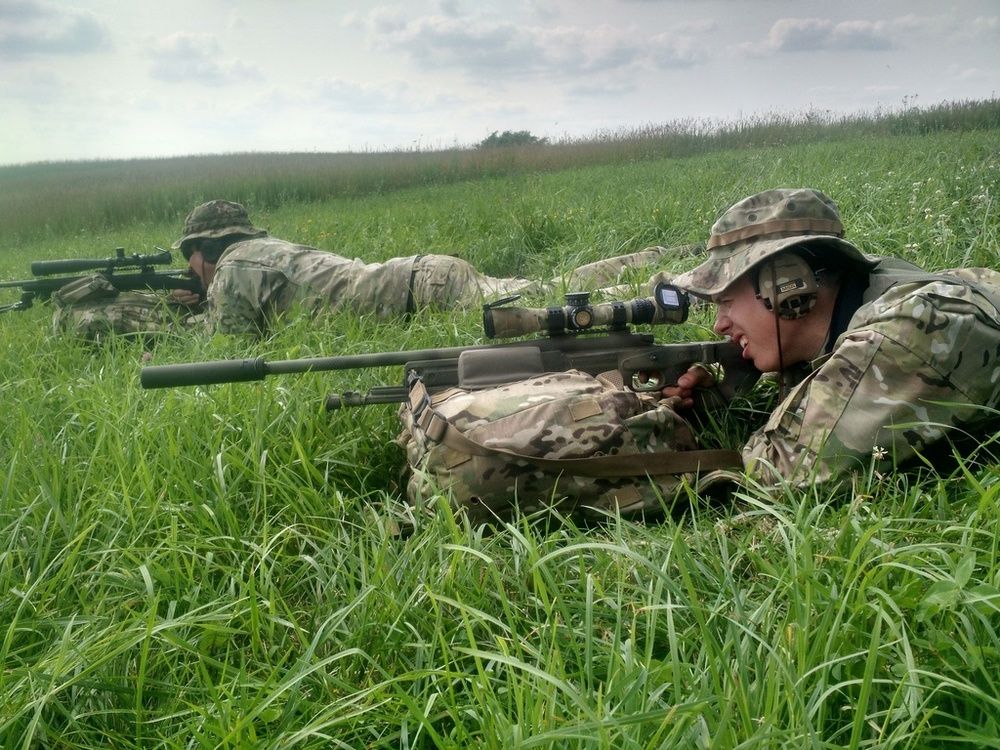
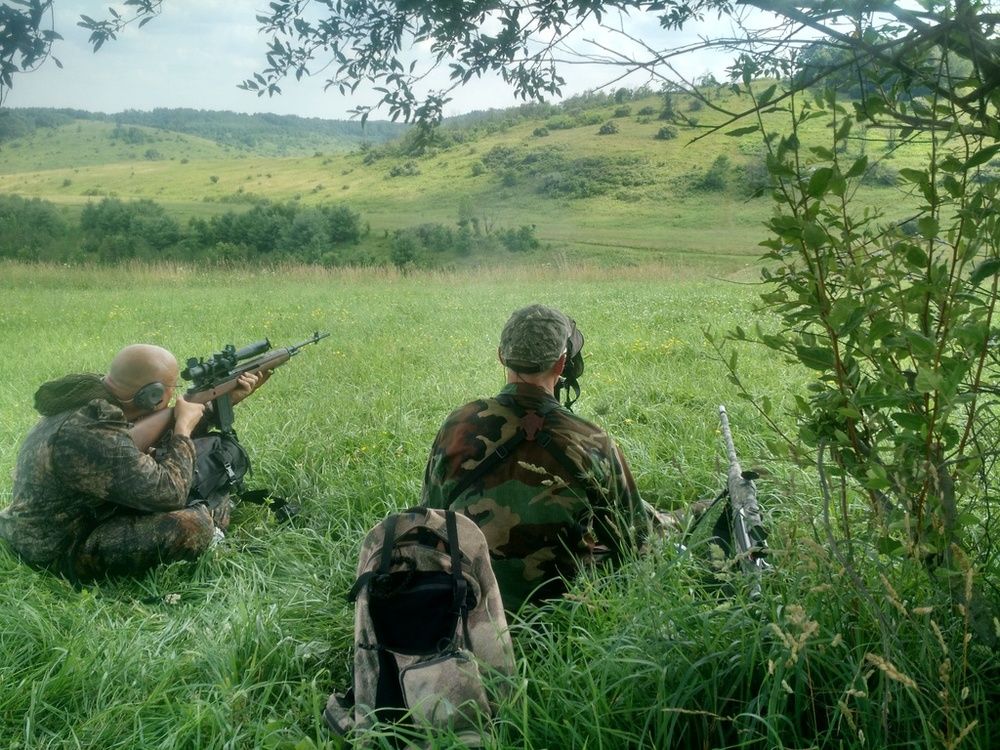
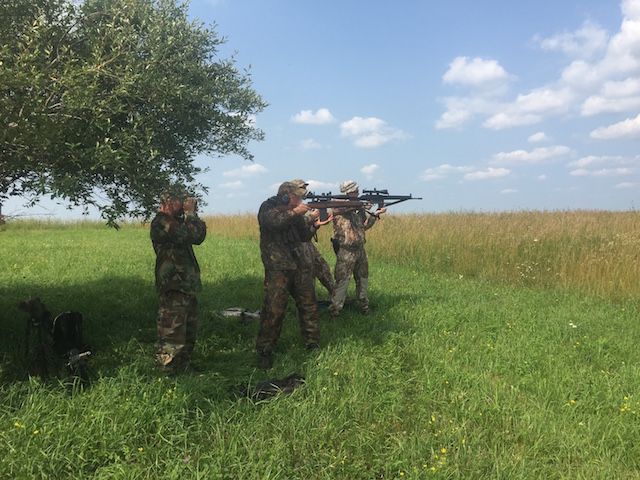
One of the students who was shooting a 7mm mag found after firing that he was unable to move the bolt on it. When we got back to the firing line he and Eric used a hammer and a block of wood to pound the bolt handle open. Then they had to get a range rod and pound the cartridge case out of the chamber. The case had experienced a primer pocket failure, with the primer pocket now about 50% larger than it was supposed to be.
Our last organized drill of the day was doing handgun transitions from prone. If you’re shooting a bolt gun and are suddenly confronted by an opponent at close range, the rifle may not be the best tool (a semi-auto is a different matter). Eric showed how to get off the gun and draw your pistol to engage targets to the front, sides, and rear. We did it dry, then a couple of students asked to do it live.
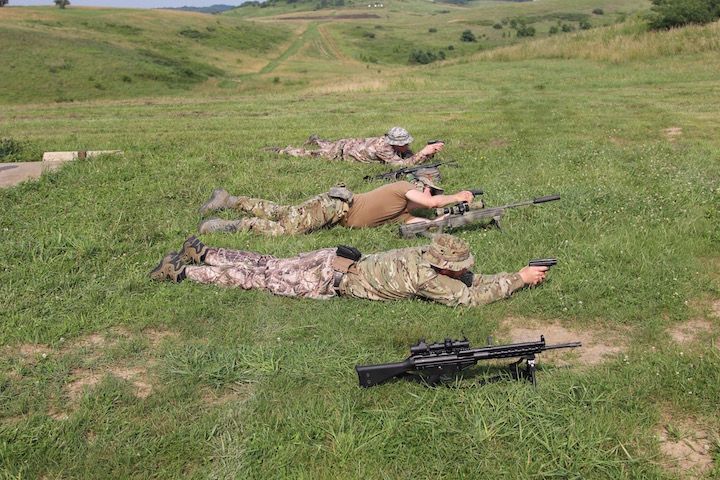




With that we started getting things packed up. Eric handed out the certificates and we did a class photo. I stuck around for a bit helping Eric to get loaded up (and he had brought a lot of stuff to this class). Eventually, though, it was time to go. So I headed back to the hotel, to get some rest before two full days of driving back to Wichita.
Conclusions
This was a really great class. Eric is a top notch instructor and this sniper stuff is really his natural element. I had an awesome time.
For me, this class was also a big contrast with my first sniper class with Eric 4 years ago. That class was my first long range rifle class of any sort, and my first real experience shooting with magnified optics. I learned a lot back then, but my abilities were pretty limited. I really struggled to get hits at 600 yards. Now, thanks to a good bit of development of my shooting skills (and an investment in better equipment, especially optics) I’ve got a lot more confidence in my shooting skills.
In particular, I was very happy with how many first round hits I got in this class. The fact that we didn’t have a lot of wind helped, but even taking that into account, I think my shooting was pretty good. Once I got my zero refined on the first day I was able to get first round hits more often than not, save on extremely distant (1000 yards) or extremely small (headhunter) targets.
I also ended the class feeling good about doing mil ranging. I’d heard the lectures and done the miling exercises in other classes before (several of them from Eric), but I hadn’t really felt confident in my ability to apply these methods and get good ranges. After this class that’s changed.
My gear for the class generally worked pretty well. Both rifles performed nicely. Shooting a relatively light .300 Win Mag did beat my shoulder up a bit. From good solid prone positions it’s actually not bad, but from jackass or less than perfect positions it can definitely beat on you a bit. One negative to the Win Mag, compared to say, a .308, is that it’s a lot harder to self-spot with the harder recoiling magnum rifle. When I was taking the really precise shots the trigger was also a bit challenging at times. I was able to combat this a bit by modifying my finger position, moving it down to the bottom of the trigger rather than the middle. I’ll probably try using some of the built-in adjustment on the accutrigger to see if I can lighten up the trigger break a bit. The only other annoyance with the Savage is the 3-round magazines, combined with the fact that they can’t reliably be inserted on a closed bolt. I also need to come up with a better method for carrying extra win mag ammo. For the field stuff on Saturday I ended up bringing a 50 round ammo box with a bunch of kleenex stuffed in the top to keep the rounds from rattling. After shooting alongside Georro a bit I think I need a real mag-fed bolt gun (I’m thinking a 16″ .308 that would also be a nice host for a suppressor).
My DMR AR shot very nicely. The bipod, stock, and can made this gun a real pleasure to shoot (and obviously recoil is not an issue). As I mentioned earlier, I think the 1-6x scope is probably the limiting factor on this gun, but even working with the optic I found it to be very accurate. It’s definitely going to get an optic with more magnification and a finer reticle. I still really like the Leupold Mark 6 as more of a fighting rifle scope, so I think I need to build another rifle to go under it.
While they didn’t get a lot of mention in the writeup, my Vortex binos worked great. I used them quite a bit to locate targets, for spotting at closer distances, and during the observation exercise. Their small size made them easy to throw in a cargo pocket to fulfill Eric’s “always have binoculars on you” requirement.
My spotting scope did good duty as well. Having the reticle in there is a real huge benefit. Since both Georro and I were running scopes with mil reticles and adjustments we could use the reticle in the spotting scope to call out adjustments in mils and apply those directly to our turret adjustments and holds. This is a lot quicker and more accurate than the spotter trying to guess how far off the shot was in inches, then the shooter trying to do mental math to figure out how much of an adjustment to make to correct.
The rest of my kit worked pretty well. The only real annoyance I ran into was that my Eberlestock pack was a bit to thin for some of the shooting off of it that I needed to do, putting the rifle lower than I would like. I may need to attach a bigger outside pocket on the back with MOLLE.
This was the first time I used the dropped and offset Safariland ALS with a ruck that has a waist strap. It worked quite well, dropping the pistol below the pack strap without the trouble and discomfort of a drop leg rig.

